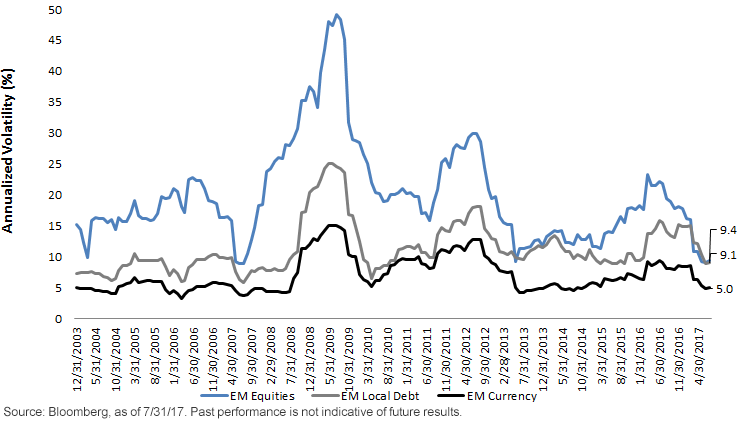Year-to-date, over $32 billion has flowed into emerging market (EM) exchange-traded funds (ETFs) in the U.S.1 As a consequence, EM equities, bonds, and foreign exchange (FX) markets are outperforming most developed markets by a sizeable margin. Despite a proliferation of choices over the last several years, WisdomTree continues to advocate a multi-asset approach to EM. Below, we contrast the various risks and drivers of return for EM FX, equities, and the fixed income market.2
How Much Risk (Volatility)?
One of the more puzzling issues for global investors is the general lack of volatility across major asset classes. Emerging markets are no exception. As the chart below shows, returns have been strong and volatility has generally been declining, similar to other markets. In the case of EM equities, volatility has fallen to levels not seen since 2007.
Rolling 12-Month Volatility (%)

While we are not in the camp that says low volatility implies that a market correction is imminent, it is notable that EM equity volatility has dipped below EM local debt over the last 12 months. This is attributable to several factors, most notably the underlying currency exposure difference between the equity index and bond index.
Equities: More In Asia with Lower FX Volatility, Fixed Income More in Latin America with Higher FX Volatility
Due to underlying macro conditions, currencies in Asia tend to be less volatile than currencies in Latin America. EM equities have over 72% of their exposure in EM Asia compared to the EM local debt3 which only has a 23% weight.4 Therefore, even though the underlying asset of equities may be higher than bonds, the overall exposures may not always tell the same story.
The last time volatility converged in this way was 2013 during the “taper tantrum.” For the 12 months ending June 30, 2013, returns between EM local debt and EM equities were similar (1.32% versus 2.87%). However, in the next 12 months ending June 30, 2014, EM equities outperformed EM local debt by over 1,000 basis points while maintaining comparable volatility. With volatility particularly difficult to forecast, we would continue to advocate EM equity risk over rate risk in the low-volatility, low-interest rate environment.















No Comments